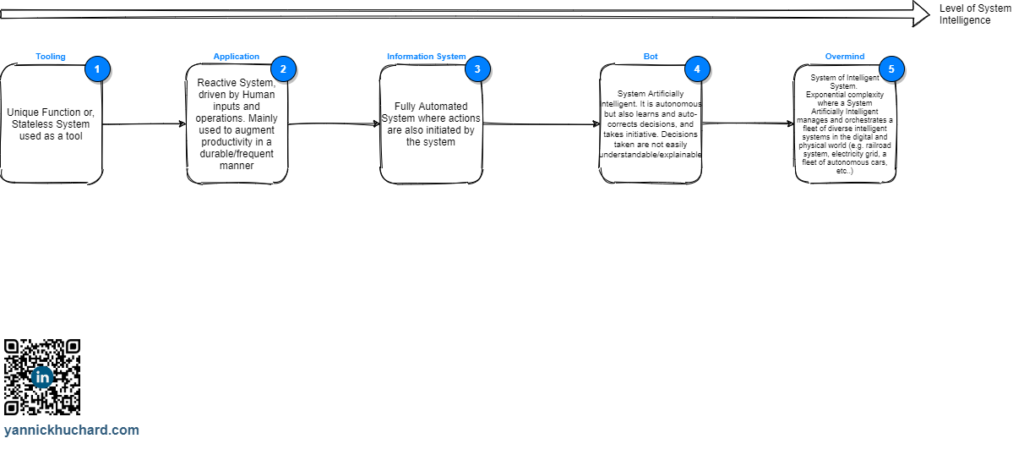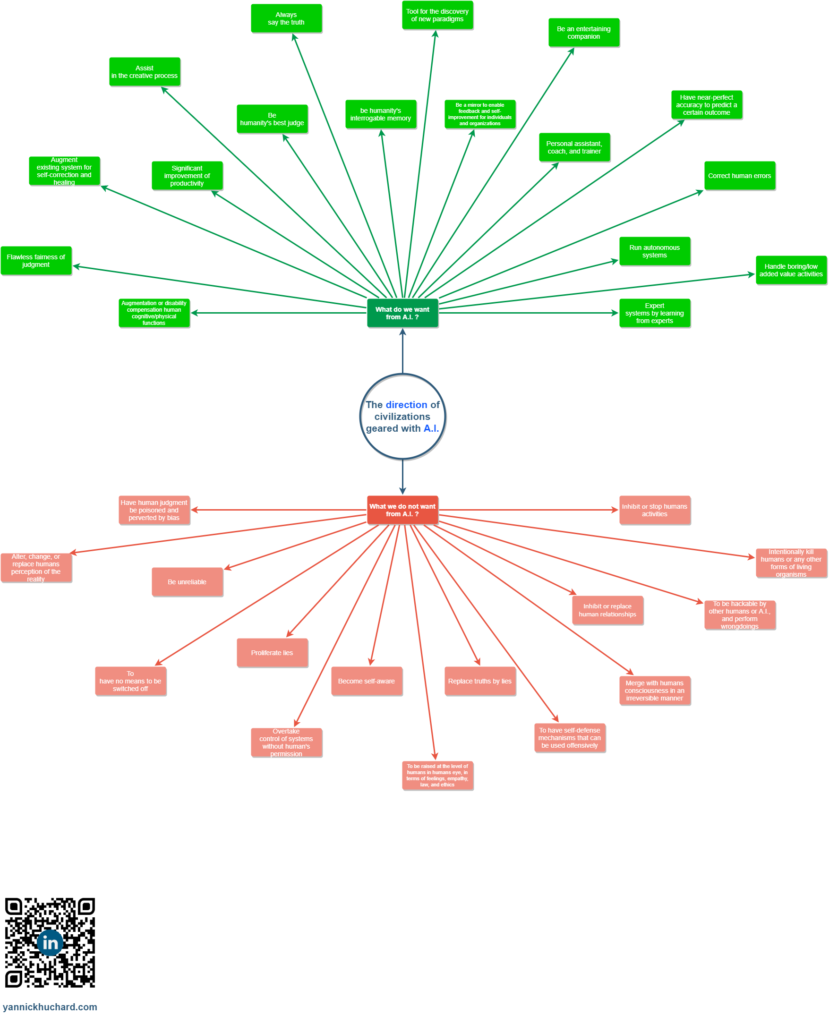It is 16h47, the 4th of June 2060.
I am sitting in my garden watching my granddaughter, Aleïs. She is playing with one of her advanced robotic toys, a Tyranausore Rex, and a ghost diplodocus. Yes, an invisible diplodocus. At least, this is what it looks like with my naked eyes. She is seeing more things despite she wears corrective glasses. In reality, she is playing with another digital dinosaur that only exists in the digital world. Glasses come with augmented reality by default, even for kids now. I remember when Apple launched them for the first time for the mainstream. I was just before the 5th digital revolution came, the age of the Phygital Internet
First, it was a gadget, it became rapidly a social advantage, to conclude as a social divide. It became indispensable when Apple partnered with major Glassmakers. Wearing glasses was no longer a sign of disability but a sign of “Augmentation”.
Suddenly Alëis sees virtual options popping atop The T-Rex. Some of them are locked and can only be obtained as “in-thing” payment. This kind of payment is sneaky but convenient, but sneaky! Of course, she wants to see the brand new flame animation coming out of her toy, and she wants to download cool dance moves like in Fortnite back in the day. She is into robotic animal engineering. She is much more skilled in information technologies than I was at her age. Like me, she is thrilled by trying and messing with new techs. I am so proud of her.
She taps on the menu to buy it. She is 14, and at this age, she cannot buy anything without the consent of one of her parents. One of the good features was family group management and sharing of financial assets and digital rights. Because I am an elder of her family, I receive her authorization to buy.
My Smartphone displays a notification. I smile because now they are holographic. And even when I am still amazed to see holograms popping out of the screen, smartphones are nowadays considered a relic from the past. Never mind, I am old anyway, I too am a relic. I should have died a long time ago. But they print organic lungs now, turning pneumonia into vintage flu. I put my finger on the notification and I approve with my face and my voice.
It reminded me of something. I say to Aleïs “There you go. You’re lucky, 15 years ago you couldn’t buy this option yourself”.
And she replied, “What do you mean, Papi Yannick?”.
“You see when I was younger, my mother had to go to the bank to open my account. I had to fill out some paper, present a printed copy of my national id card, and sign the paper with a pen. Later on, we could do it with our smartphones. Digital Onboarding was the coolest thing. We struggle to make it happen due to the strict regulations of the financial industry. Cyber fraud was high, and trust in the system was low. Eventually, the governments decided that laws had to be strictly enforced by code. You know, IT programming. Actually, this was the birth of the now famous expression “In Code We Trust”. Now everything is different. I mean normal for you but different for me. Ever since financial matters entered the Universal Declaration of Human Rights, it did change a lot for the good. Now each human has a bank account the moment they land on planet earth. It is a birthright. Of course, they have to pay if they want more options, like your T-rex! If I recall correctly, Mankind agreed on changing the law after the COVID-19 pandemic.”
“Now look at that. You can ask permission to pay with your glasses. Then I can approve it with my relic. You get the right to spend the money from your bank account. Finally, you get a T-rex spitting flames and dancing like Justin Bieber!”
“Justin Bieber? Papi, you are soooooooooo old”
“Yeah… I know”
“But I know things that you don’t”
“Ok tell me! Tell me pleeeeaaaassseeeeee!”
“Did you know that, in fact, you are not paying directly? It is your T-Rex that sends a payment to Amazon?”
“Seriously??? How come???”
“Ok. When I was still working at the bank, we figured out that autonomous cars were always connected to the internet because they needed specific cloud resources. As you know, the management of a fleet of cars is completely reliant upon the vehicle’s intelligence and collective intelligence. To operate correctly, each car needs to dynamically allocate computing power. I mean significant computing power. Now everything is quantum computing and photonic memory, it was ridiculous compared to now. The allocation is performed by buying volumes of TPU in the Financial Stock Exchanges. Funny story though, this is how Nvidia came to dominate by far the NASDAQ.
Besides, these cars were expensive to make. Thus, they needed to come with insurance from a third-party company. So what we decided at the bank is to create a bank account for Things. Nowadays, we generalized this concept to almost all objects. Fridges, washing machines, carrybots, you named it. So, in your case, the T-rex you received on your birthday has:
- a bank account
- a 10 years insurance bound to it
- a return policy that mummy and daddy can use if they want, and the list of features unlocked
There is also a piece of information that says “this T-rex belongs to Aleïs Huchard”. Thus even if you lose it, someone can bring it to the nearest Post office and a delivery drone will bring it back to you. Isn’t that great?”
“How does the bank knows that it is mine?”
“Actually the bank does not know. The bank information system request the Worldwide Identity Service — a blockchain so to speak — to verify that this object is yours and it is safe to send a payment to Amazon. And since the monthly spending limit on your toy that your parent has set is not reached, you can buy your options. I mean the T-rex can pay for its hot upgrade, ah ah ah!”
We are both laughing loud together.
I continue with “ What do you want for your upcoming birthday? I was thinking about a trip or something”.
“Yes, I’d like to go to Senegal. You find the best Agrotech schools there.”
“You’re already thinking about university? Geez, you’re growing so fast.”
“Indeed. According to my personal finance advisor, we all have to save €20 per month on our “special event group account”. Annnnnd, this is me supposing I’ll receive €50 from you, Granny, Mummy, Daddy, and auntie Azea at my birthday!”.
“Yeah, sure you can count on that…. When did you become so good at finance?”
“I simply asked my personal financial advisor.”
“Can you show me?”
“Sure, here it is”. She looked at me with her glasses and made a swipe gesture in the air like I used to do on my NotSoSmartphone.
A hologram pops up. I was expecting a dude in suit-and-tie, like… a banker. How cliché. Instead, it was an oldish robot covered with rust. And says “How may I help you, Yannick”.
“Show me your list of features, please?”
“Sure, here it is”
A mind map of all features floats in the air. Then I say “I get it, this is an upgraded version of mine. I guess I should ask questions more often to my own personal advisor to train it with my needs. Or even better, I am going to ask your personal finance advisor to train mine. Although mine looks much more friendly. Why this robotic face, Aleïs? It looks like a half-baked Optimus Prime!”
“Don’t you like this skin, Papi? If you don’t like it, just change it. You can replace skins and voices. Check the marketplace.”
“Hmm… Open the marketplace please”
Now I am checking the marketplace. I see a lot of stuff produced by independent artists. Ever since ING came up with the “Platform Bank” idea, all Banks built their own “Financial Auchan”
See that, I can buy ad spaces on social media… Buy games on Playstation XR… Hmm… Buy tuition to the Elon Musk School of Technology… And, oh, even get me the avatar of Gary Vee for defining my attention strategy. Sweet.
Ah… Skins…
Oh, you can even buy Investment Strategies too !? “The Warren Buffet Strategy by Eleanor Neetz”… “The Silent Investor, by the Wall Street Journal”… “The Sustainable Index Strategy” is currently trending. And they even have a leaderboard now. Wow, did you know that the top performer of the month won €34023! Little one, your friends, and you should buy this strategy to fund your trip!”
And she replies “You prefer Social Network Investments to cool Skins, Papy? Your so oooooooooold!”






